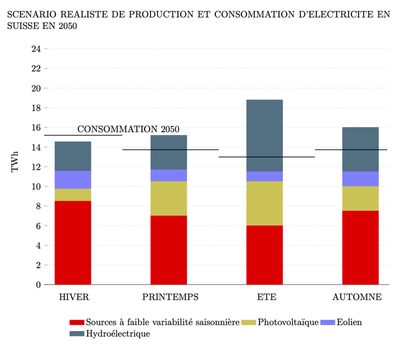Why is seasonal storage a central issue for our future energy system?
Switzerland produces a surplus of electricity in the summer but cannot meet its needs in the winter and must therefore cover this deficit with imports. This trend is likely to increase. Transferring this summer surplus electricity to the winter semester through seasonal storage would reduce our energy dependency on foreign countries.
Today, Switzerland covers its electricity needs from May to October with the output of its nuclear and hydroelectric power plants. A large surplus of electricity is even exported in July and September. On the other hand, Switzerland has to import massive amounts of electricity during the winter season, when demand far outstrips production [→ see figure below].
This situation can be explained by a combination of unfavourable circumstances. On the one hand, electricity consumption in Switzerland is 20 to 30% lower in summer than in winter, a difference that is mainly attributable to the use of electric heating systems [→ Q26]. On the other hand, Switzerland’s own electricity production is currently 10-15% higher in summer than in winter, despite the lower output of our nuclear power plants in the summer. This is mainly due to the hydroelectric production differential of run-of-river facilities, as river flows are much higher in summer than in winter due to snowmelt.
The shutdown of our nuclear power plants, the increase in hydroelectric capacity, and especially the deployment of solar (photovoltaic) electricity will increase this seasonal asymmetry. We will find it increasingly difficult to cover our winter electricity needs, while we have the means to exceed our summer demand. There are many energy transition scenarios in which we will increase our electricity exports in the summer when demand and prices are low, and our imports in the winter when prices are higher.
If we could store this excess summer electricity until the following winter, we could significantly increase our energy independence, improve our energy balance of payments, and increase the share of renewable (solar) energy in our consumption mix. Seasonal storage nevertheless remains a major challenge, particularly from an economic point of view [→ Q73].

References
- Office fédéral de l'énergie (OFEN) (2018)
- Office fédéral de l'énergie (OFEN) (2018). Statistique suisse de l’électricité 2018. OFEN.
- Office fédéral de l'énergie (OFEN) (2019)
- Office fédéral de l'énergie (OFEN) (2019). Statistique globale de l’énergie 2018. OFEN.
- Schleiss (2012)
- Schleiss, A. (2012). Talsperrenerhöhungen in der schweiz: energiewirtschaftliche bedeutung und randbedingungen. Wasser Energie Luft, 104(ARTICLE). 199–203.